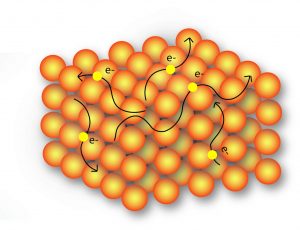Condensed matter physics is the physic of many! We study the interesting and useful phenomena that happen when a septillion electrons and a septillion atoms all interact with each other in close proximity.

There are many reasons why condensed matter physics is interesting!
See also: Joys of condensed matter physics
Basic Science: A septillion interacting particles yield nearly infinite phenomena that push our understanding of physics with every discovery. Condensed matter physics seeks to find fundamental truths about interacting many particle systems which can then be used for applications or for informing other fields of science. One theme in modern condensed matter research is emergence–the idea that the collective properties of a many-particle system cannot be understood with a reductionist approach (more is different). Many of the materials we study fall under the umbrella term ‘quantum materials’ which encompasses diverse classes of materials which manifest emergent phenomena.
Technology and medicine: Much of our modern technology, including the device you are using to read this page, originated from advances in condensed matter physics. In the early-mid 20th century, scientists struggled to understand how electrons move in silicon, how impurities can be used to engineer desired electrical properties, and how this material could be manipulated to produce devices called transistors. Once these basic science questions were answered, these transistors could be engineered to become ever smaller (Moore’s law). Similarly, the advancements being made in novel materials in this department may form the basis for the next generation’s technology. Another example is magnetic hard drives, which were only possible after scientists learned the mechanism of different types of magnetism and manipulate them in ever smaller bits. Similarly, groups in our department work on understanding and manipulating the next generation of magnets. Finally, hospital MRI machines use superconductors to product high magnetic fields and use the principle of nuclear magnetic resonance (NMR) to make measurements; faculty in our department study the next generation of superconductors and do experiments that also use NMR.
